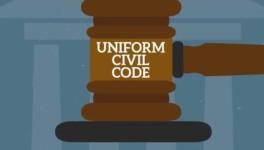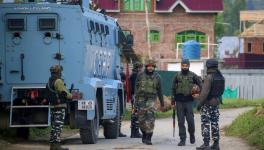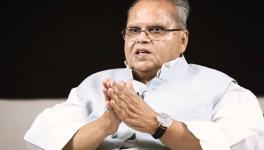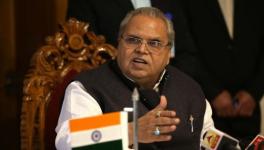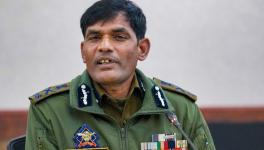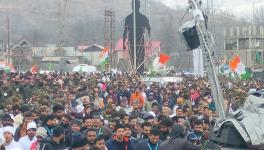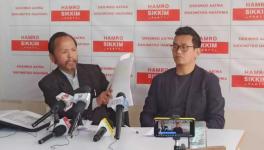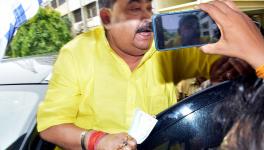How Sikkim Became the 22nd State of India
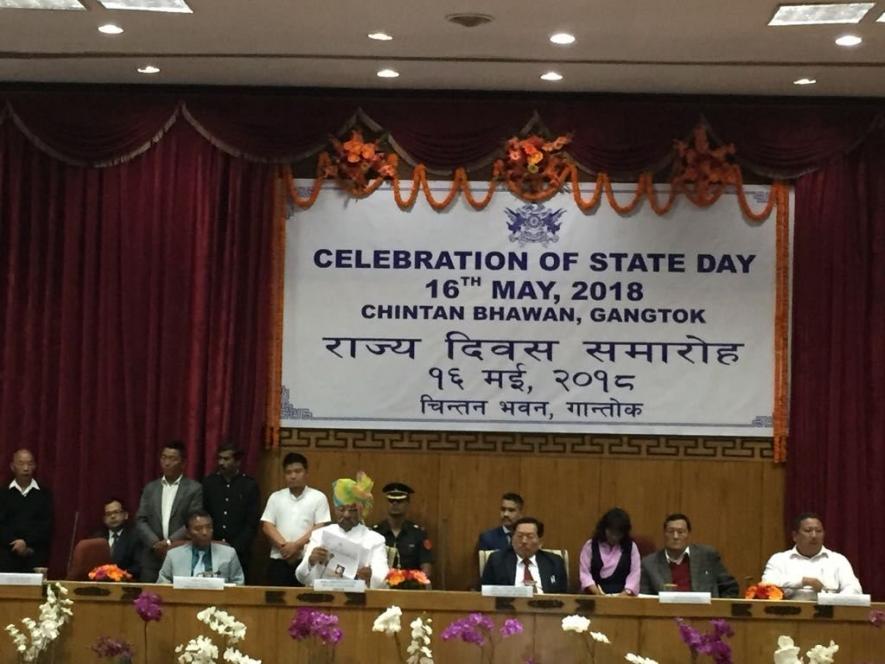
Image Courtesy: Voice Of Sikkim
Today, on May 16, Sikkim celebrates 'statehood' day. The grand irony is that this is the day Sikkim officially went from a semi-sovereign entity to that of just another Indian state. Governor Shriniwas Patil addressed the people of the state by mentioning the “best in class services” provided to the people of Sikkim, as well as that Sikkim is always praised by visiting dignitaries. He mentioned the rail link at Rangpo that has been cleared, and the newly completed Pakyong airport. Never mind that the key motive behind both these projects was probably defence, and not improving the lives of the people. However, what would be worth revisiting is how a semi-sovereign entity became a federal state within the Indian Union.
Two editorials written by late B. G. Verghese, the then editor of the Hindustan Timesraised a few fundamental questions over Sikkim. These editorials costed him his job. On August 30, 1974, he wrote an article titled ‘Kanchenjunga, Here We Come’in which, he questioned the move to give Sikkim representation in Parliament, even though Sikkim was not (yet) an Indian state. Its lead paragraph set the tone of the editorial. “If it is not outright annexation, it comes close to it. To suggest anything less would be self-deception and compounding dishonesty with folly. Sikkim is to be reduced from a protectorate to a colony through nominal representation in the Indian Parliament.” He then clarified what he was referring to, “[t]he reference to Sikkim's desire for closer political association with India was written into the recent Government of Sikkim Act, drafted with Indian assistance under Indian supervision and, who can blame the critic for assuming, possibly not without some little Indian blandishments or tutoring.” Essentially, his editorial stated what the common people of Sikkim knew and watched unfold before their eyes as their movement for democracy was hijacked by the Indian government through the Research and Analysis Wing (RAW).
His second editorial, on April 17, 1975, was the final nail. In this editorial, he challenged the “the so-called referendum which demonstrably could not have been held and completed in a fair or reasonable manner within 72 hours”. He began by attacking the speed at which the referendum was conducted, then moved on to the way the question printed on the ballot paper was framed. The question was written as “[t]he institution of Chogyal is hereby abolished and Sikkim shall henceforth be a constituent unit of India.” Any rational individual can see that the single question concerns two separate issues; firstly, abolishing the monarchy (Chogyal), and secondly, Sikkim to merge with India. The manner of framing was entirely wrong, as people opposed the monarchy and to merger, had no say whatsoever.
Sunanda Datta Ray's famous book Smash and Grab: Annexation of Sikkim, though never banned, was drowned in defamation proceedings by Indian officials, whose nefarious roles he had exposed. By the time the book was published, the story of Sikkim disappeared from the minds of the Indian public. Not to mention that by then, the Indian intelligence apparatus was fully entrenched in the erstwhile kingdom. Apart from Indian journalists opposing the 'merger', former Prime Minister Morarji Desai told The New York Times in 1978 that the merger was “not a desirable step”. However, he also stated that he cannot undo it. Though the 'facts on the ground' have now been changed, at the time, he could do something about it. On the one hand, the Constitution of India does not allow for India to part with territory, however, the decision in In Re: Berubari Union Case, 1960, stated that legislative action was necessary to cede territory. This led to the 9thAmendment to the Constitution which enabled India and Pakistan to split the territory.
So what were the events in Sikkim that led to the referendum that had led to the then PM's comments? It all began in 1949 when the democracy movement in Sikkim, which was led by Chandra Das Rai among other Sikkimese of Nepali origin. The leaders spurred by the socialist ideals learnt in Darjeeling, even requested Nehru to merge Sikkim with India at one point, which he declined. The democracy movement had succeeded in establishing a fledgling democracy, however imperfect, in the kingdom. In 1950, an unequal treaty was signed between India and Sikkim, which reduced Sikkim to being a 'protectorate'. The democratic reform instituted in Sikkim was greatly influenced by Nari Rustomji, an Indian bureaucrat and a close friend of the last Chogyal of Sikkim. The problem with the reforms, however, soon became apparent. The issue was that despite Sikkimese of Nepali origin were accepted as subjects of the Chogyal, in elections, one vote cast by the minority Bhutia and Lepcha communities would be counted as six votes, whereas one vote cast by the Nepali community was counted as one vote. This disparity soon led to protests.
The reasoning behind the move to assign differential treatment based on linguistic groups was that the Nepali speakers comprised an overwhelming majority of the population. The move was to ensure that the other two communities – Bhutias and Lepchas – were adequately represented. However, the issue with this line of thinking is that the kingdom of Sikkim was established in 1642, the kingdom of Nepal was established in 1768. This is significant because the borders of Sikkim expanded and shrank with time. Several communities that are today regarded as 'Nepali' communities lived in Sikkim before either of the two kingdoms were established. The fact that matrimonial relations between several communities that traditionally live in the area comprising Sikkim and Eastern Nepal and Lepchas are not taboo, should suffice; matrimonial relations between Lepchas and Bhutias require a 'penalty' to be paid for marrying outside the community.
The discontent among the Nepali-speaking populace grew. This resulted in the movement for one-man one-vote. Local community organisers such as Rabong Saila led protests in Gangtok. Though born to a peasant family as Chetan Das Rai, he later adopted the name Kaloo Rai, until he was given the name Rabong Saila. Rabong Saila means the third son of Rabong – Rabong is now officially known as Ravangla. He earned this name due to his entrepreneurial skills as a petty businessman. He eventually was appointed to the Chogyal's Executive Council heading the PWD.
Finally in 1973, the 8thMay Agreement signed between the Government of India – who was called upon to mediate – the Chogyal, and the people of Sikkim represented by three political parties. The agreement established a democratic system on the basis of universal adult franchise and the principle of one-man one-vote. However, the agreement led to greater Indian executive involvement in Sikkim's politics. The political officer in Gangtok, though officially expected to behave as an ambassador, instead assumed the role of a governor with none of the oversight the Constitution of India provides. After the agreement – as has been lucidly described in both Dutta Ray's book as well as in Andrew Duff's Sikkim: Requiem for a Himalayan Kingdom– the Indian mission, in connivance with the intelligence agencies, engineered protests and elections until a malleable assembly headed by Kazi Lhendup Dorji was formed.
This malleable assembly was finally tasked with passing an Act to enable Sikkim representation in India's Parliament. The Act resulted in litigation filed against it. However, to outdo the case that was still sub judice, a resolution to merge Sikkim with India was tabled. Upon hearing news of this, the local populace was up in arms. Protests shook Gangtok to prevent the resolution from being even discussed. It is pertinent to note that opposition to the protests included Sikkimese of Nepali origin as well as Bhutias and Lepchas. The CRPF, who had been brought to Sikkim, were then used to charge down the protestors, the press – apart from those willing to report what they were told to – were barred from entering Sikkim. Eventually, the hand-picked assembly was herded into the building to pass the resolution by armed guards. By then, the members – who former CM, late Nar Bahadur Bhandari referred to as batisey chor, and desh bechowa – had either been bought or were coerced into passing the resolution. Those, who could neither be coerced nor bought, were jailed on trumped-up charges.
Upon passing the resolution, the infamous referendum was held. According to those who voted, the CRPF informed them what to vote for. The fact that the vote was not unanimous should bear testament to those brave souls who were not cowed by the guns and boots. This episode costed Verghese his job. The editor of the Bengali journal Aneek, Dipankar Chakrabarti was jailed for publishing his views against the 'merger'. However, the people of Sikkim lost a country. At present, most people in Sikkim are either unaware of what happened or do not care. The amount of money that entered Sikkim after the 'merger' was presumably sufficient to buy the people's loyalty.
Get the latest reports & analysis with people's perspective on Protests, movements & deep analytical videos, discussions of the current affairs in your Telegram app. Subscribe to NewsClick's Telegram channel & get Real-Time updates on stories, as they get published on our website.










